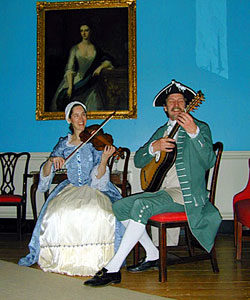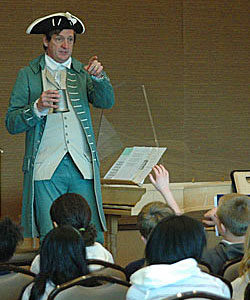Tunebook: David and Ginger Hildebrand
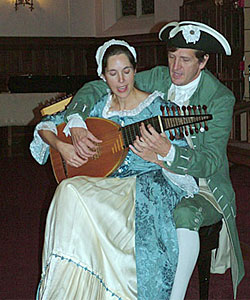
David and Ginger Hildebrand co-founded the Colonial Music Institute, which conducts and promotes research and offers information and resource materials for students and fellow scholars, as well as helpful publications and online databases for researchers and teachers. CMI encourages primary research enlightened by interdisciplinary scholarship, and publishes sound recordings, CD-ROMs, sheet music, books (scholarly and performing editions), and online databases and other resources for researching American music and dance of the seventeenth through early nineteenth centuries. CMI’s online materials include essays, lists, indexes, and other useful information. We also offer consulting services for archivists, curators, film producers, and collectors.
We are simultaneously performers and educators in the field of early American music, broadly covering the period 1720-1820. Our mission is to teach American history through music that informs us about society, politics, heroes, and battles and through the varied voices of master and slave, Rebel and Tory, man and woman, and Southerner and New Englander. There is no single point of view in our repertoire.
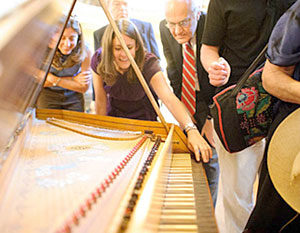
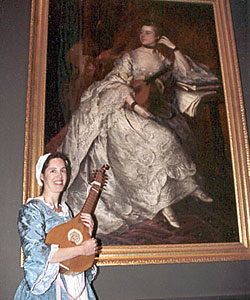
We were initially drawn to early American music by our audiences. When we began performing together professionally in Annapolis in 1980, audience members would ask sometimes: “Do you do any colonial music?” We got curious, found plenty of interest and demand, and within several years narrowed in on this specialty. Thirty years, three graduate degrees, and seven CDs later, we’re still fascinated. After all, this music resonates with our classical training (piano, violin, guitar) and appreciation of European art music as well as our love of traditional American music. The beauty of appropriate instruments for music caught our attention, too. We normally bring quite a few of them to the concert stage: harpsichord, violin, English and German flutes, hammered dulcimer, baroque guitar, English guitar, and djembe. Every time we set them on stage they captivate the audience—not just through their sounds but through their appearance. Curious audience members always come up to the stage for a closer look after a program.
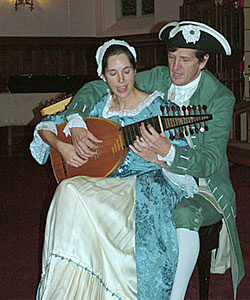
Much of what we do depends on creating the context. Beyond the detailed program listings and notes, we talk to the audience about each piece, providing historical setting and things to listen for. We nearly always appear in period attire, colonial c. 1770 or 1812, depending upon the program. We don’t perform in character, but rather address the audience as intelligent people of the twenty-first century. Our appearance increases the audience’s ability to “get into” our music, and it helps us assume a natural presentation of music so different from that of today. David’s gentleman’s overcoat forces him to stand and sit with good posture, for instance, thus improving the delivery of upper-class theatre songs. Explaining the parts of clothing at the beginning of a children’s program really draws them in and clarifies the gender differences in musical practice that we’ll later demonstrate. Not surprisingly, we prefer to perform in small historic spaces with great acoustics! An intimate space, such as the auditorium at Mount Vernon, requires no amplification and allows for informality. But we do our best to project this sense in larger halls as well.
Visit The Colonial Music Institute’s website.
Sound files:
1. “Over the Hills and Far Away,” from The Beggar’s Opera. David Hildebrand, voice and guitar; Ginger Hildebrand, violin. Track taken from Over the Hills and Far Away, being a collection of music from 18th-century Annapolis (1990). Courtesy of David and Ginger Hildebrand.
2. “A Toast,” by Francis Hopkinson. David Hildebrand, voice and harpsichord; Ginger Hildebrand, voice and violin. Track taken from George Washington, music for the first president (1999). Courtesy of David and Ginger Hildebrand.
3. “Dieu d’Amour,” by Andre Gretry. Julianne Baird, voice; David Hildebrand, voice and guitar; Ginger Hildebrand, voice. Track taken from Music in the Life of Benjamin Franklin (2006). Courtesy of David and Ginger Hildebrand.
4. “The Rising Sun.” David Hildebrand, recorder; Ginger Hildebrand, hammered dulcimer and violin. Track taken from Music in the Life of Benjamin Franklin (2006). Courtesy of David and Ginger Hildebrand.
5. “Decatur and the Navy.” David and Ginger Hildebrand, voice. Track taken from the recording Music of the War of 1812 in America (2011). Courtesy of David and Ginger Hildebrand.
This article originally appeared in issue 13.2 (Winter, 2013).
